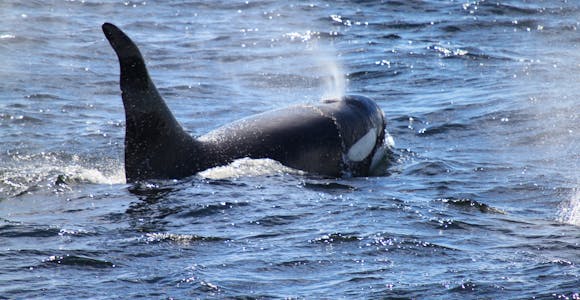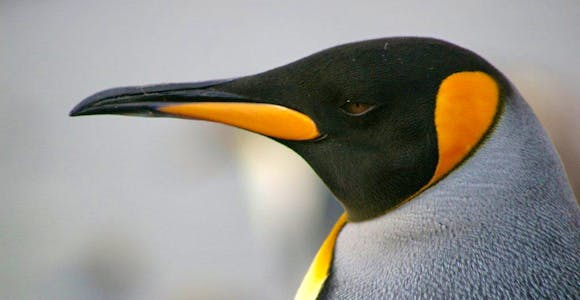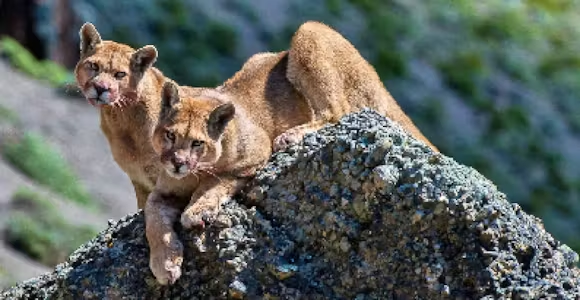
Whale Watching in Patagonia
Join a dedicated whale-watching cruise or boat trip with specialist guides to protected fjords and bays in either Chile or Argentina to observe Patagonia's whale up close.
Discover MoreDeep roots in Patagonia: We are ex-guides, tour leaders, outdoor enthusiasts, & adventurers.
We’ve got our feet on the ground: Impartial advice, a bespoke service, and at no extra cost.
For the ends of the Earth: Sustainability is more than our carbon footprint (but we’re reducing that too).

Patagonia is home to over 460 species of birds, making a trip to Chile or Argentina an unforgettable experience for any birder. From the famous and dominating Andean Condor swooping high above you to the tiny Austral Pygmy-Owl's screeching call at dusk, there are birds to find everywhere.
Patagonia's birdlife is rich and varied, with over 460 species of birds, around 30 of which are endemic to Chile and Argentina. To get the best bird watching experience, we recommend:
Every region of Patagonia holds its own birding delights, but some regions are particularly special. Our top destinations include:
Chilean Lake District - an area of temperate rainforest, grasslands and wetlands, and one of the best birding spots in Chile, the Maullin River.
Tierra del Fuego - a diverse, rugged terrain, famous for penguins and condors, but home to much, much more.
Peninsula Valdes - this area is a well-known wildlife hub. When you're done spotting flamingoes, petrels, cormorants and penguins, look out for whales and sea lions almost on your doorstep.

Penguin reserves can be found throughout Chilean Patagonia, from Punta Arenas and Ushuaia to Peninsula Valdes, and Chiloe Island. Magellanic penguins are the most widespread of the breeds to be found in Patagonia, but it is also possible to see Humboldt penguins, gentoo penguins, and even king Penguins.

The Andean condor (from the vulture family) can be found throughout Patagonia. Often seen circling the iconic Torres del Paine, or above Laguna Armaga, swooping down to feast on the remains of a puma's guanaco kill. This impressive bird has a wing span of 3.2 metres, the largest of any land bird. It is currently considered as 'nearly endangered' by the International Union for Conservation of Nature.

The magellanic woodpecker has a shiny black body with a white 'V' on it's back, a white underwig patch and a yellow iris. The male has a scarlet red head whilst the female's is black. You can locate this large woodpecker by their loud, two note hammering drum or their two syllable call. The magellanic woodpecker can be found in the Nothofagus and Nothofagus-Austrocedrus forests of Bernardo O'Higgins National Park or along the Beagle Channel in Magallanes.

In addition to the King penguins, we saw guanacos, flamingos, upland geese, and other birds (can’t remember them all). Read the full review
Travelled: April 2025
Lisa Jibson - USA
Nancy checked off about 80% of the birds on the Chiloe Island/Lake District checklist, thanks to our great guide Rafa Read the full review
Travelled: February 2019
Paul Miller - United States Of America
The penguin encounter was amazing!! Penguins have always been my favorite animal so seeing them in their natural environment in a place that doesn't sensationalize it but respects the colony was really a dream come true.
Travelled: December 2017
Jami & Don - California, USA
We saw many foxes, rabbits, condores and other birds. Read the full review
Travelled: December 2017
Craig Hobin - Brazil
Watching condors circling overhead as we were being blasted by the wind on rocky cliffs was memorable. Stumbling across a family of upland geese feeding and seeing a family of huemul were real treats. I could go on and on about rheas, guanaco, mara, king penguins, torrent ducks etc. Read the full review
Travelled: December 2017
Jo McGrouther - Australia
The King Penguin tour (many king penguins and their babies - just adorable) and the Birding tour (birds, geese, sea lions, wild horses and dolphins galore) were outstanding. Our guide was outstanding and personable and we saw wildlife beyond what we could have imagined.
Travelled: October 2017
Gail - Florida, USA
The wildlife was crazy, we saw condors, eagles, guanacos, giant hares, wild horses and more bird varieties than we could imagine.
Travelled: October 2017
Richard & Susan - Canada
The wildlife was surprisingly abundant and all around us, from Guanacos, Pumas (spotted while on bus!), Andean Foxes, Condors, Carpintero Gigante, Caracara, Flamingos, Ibis, Falcons which followed us to Grey Glacier, and the ubiquitous Southern Lapwing.
Travelled: March 2017
Andy - UK
The trek to see the condors was amazing, we saw so many of the beautiful birds up close and were lucky enough to see dozens of other birds, including owls.
Travelled: November 2016
Jana and Ben -
The array of ferns, fungi and birds made the challenging hike into the Tagua Tagua Park worthwhile.
Travelled: March 2016
Mary -
Also known as Darwin's rhea, the brownish-grey lesser rhea can run at up to speeds of 37 miles per hour. They have long, yellow legs and a dark horn bill. To flew danger they will run in a zig zag pattern or squat in vegetation to hide. In breeding season the males will use feather fluffing displays and deep calls to attract the hens. Several hens can mate with a successful male, leaving him with 20-30 eggs to incubate. The male will then raise the chicks, rounding them all up with whistling calls. If any chicks stray away, another male with his own young will adopt the lost chick.

Spot a Lesser Rhea roaming the steppe
This cute little owl has quite a big head, yellow eyes and a long tail. They are nocturnal and feed on small mammals, birds, reptiles and insects, sometimes taking prey bigger than themselves with their sharp, powerful talons. The pygmy-owl's small size makes it difficult to spot but you might locate one by the shrill, half screeching call when setting out to hunt at dusk. Pygmy-owl's can be found in city parks, Nothofagus forests and farmlands.

Pygmy Owl
The black necked swan has a white body and a red caruncle on a blue-grey bill. They feed on aquatic vegetation by sticking their neck and head underwater. Little white cygnets are often seen riding on a parent's back in chick raising season.

The black-faced ibis is stocky and brightly plumaged and has a long, decurved black bill with a horn-coloured tip. They have a loud, clanking call and feed on frogs, worms and other aquatic life. They nest in groups of 10 to 30 pairs and builds a large nest out of twigs and vegetation, which can be seen in treetops, cliff edges or reedbeds. The black-faced ibis can be found in meadows, marshes and newly plowed fields.

The upland goose breeds in great numbers on the semiarid pampas of Argentina. It lays 5-8 eggs in a down-lined nest of long grass. The male has a white head and a black and white body. The female has a brown head bending in to a black and white body. They are often seen gazing amongst sheep on ranches but are also found on the open plains, farmland and coasts of channels and bays.

Torrent ducks have a long stiff tail and claws at the joins of their wings. They are found along fast-flowing rivers where they swim against the strong current with ease. They use their narrow, flexible bill's to pick food from the cracks and crevices of submerged rocks. The males have a high-pitched whistle, which can be heard over the sound of rushing water.

Torrent Duck
Delve into the world of Patagonian birds with a guided birding tour, the best opportunity to spot a wealth of different species. Our birding guides are experts with years of experience, who know all the best places in their local area for those spectacular sightings.
The southern caracara is a aggressive and merciless hunter of small mammals, young birds and bird eggs, snakes, grubs and even newborn lambs. Their call is a percussive rattle which sounds like a stick being beaten on a hollow branch. They are often seen at carrion with vultures and can also be found in open fields, sheep ranches and woodland.

The chimango caracara has a buoyant flight and rarely soars. They nest in upper branches of low trees or hidden spots in the grass in treeless areas and lay a clutch of 2 to 6 red-speckled, creamy white eggs. Noisy groups of these birds can be found scavenging on the ground at open markets, in garbage dumps or fields being plowed.

This rayadito's characteristic tail ends in bare shafts, the central tail feathers are black whilst the outer has rufuos tips. These little forest-dwellers place their nests of small twigs and soft grass in cracks or crevices between the trunk and bark of forest trees. They search tree bark and foliage for insects to eat.

The rufous-collard sparrow can be found in lowland or montane scrub. They have grey heads with two broad black crown stripes and a prominent rufous collar. These little sparrows are very used to human presence and are commonly seen in urban areas. They can be found hopping on open ground as they forage for seeds and insects or singing from a prominent perch on a shrub or rock.

The long-tailed meadowlark lives in pairs or small groups and sometimes forms bigger flocks in winter. They nod and bob as they forage on the ground for beetles, small crustaceans, seeds and small bulbs of wild plants. They perch in the open on fence posts, rocks or on top of shrubbery. These little meadowlarks sing mostly in the evening when they throw back their head, puff out their throat feathers and give it some. Their song is a long, harsh and repetitive chee chee cheerie. They are commonly found in farmland, livestock pastures, damp meadows or steppe.

Austral Parakeet's form small flocks that forage together in trees and bushes. They feed on seeds, fruit, berries and buds, occasionally forages on the ground for dandelions, grass seeds, roots and bulbous plants. They nest in dead tree cavities, or build a nest of sticks in branches if tree holes aren't available. These parakeets can be found in forests, open woodland and farmed fields.

The Austral Negrito is a small tyrant flycatcher who will breed in southern Chile and Argentina before flying further north for winter. This little bird is strongly terrestrial and can be found in open areas such as farmland and beaches.

Southern lapwings are found in fields and wetlands and also take up residence in meadows, parks and gardens in urban areas. They feed mainly on insects making them very beneficial to agriculture. The lapwings strident metallic call alerts everyone and everything around them to perceived danger. The lay 3-4 large pear-shaped eggs and chicks will feed independently just a few hours after hatching.

The rufous-legged owl is known in the Swoop office as Tom's owl because of Tom's excitement in seeing one in the Pingo Valley in Torres del Paine. These dark-eyed owls live in dense woods and rainforests such as the closed canopy Nothofagus forests. Their call is sonorous and hooting.

Photos (c) Rodrigo Tapia (c) Bastian Gygli

Join a dedicated whale-watching cruise or boat trip with specialist guides to protected fjords and bays in either Chile or Argentina to observe Patagonia's whale up close.
Discover More
Patagonia is an incredible place to see penguins ('Pinguinos' in Spanish), and there is a surprising variety of species too! You'll find penguin reserves throughout Patagonia, …
Discover More
Torres del Paine is home to a growing population of the elusive puma. We work with responsible guides to give you great wildlife experiences while protecting the animals' habitat.
Discover More.jpg?auto=format,enhance,compress&fit=crop&crop=entropy,faces,focalpoint&w=580&h=300)
In addition to its famous pumas, penguins and whales, Patagonia has to an abundance of other wildlife. Home to the worlds smallest deer, over-sized rodents and endangered wild …
Discover MorePatagonia is an area of fabulous biodiversity, home to many species classified as endangered or vulnerable. We work with carefully selected local partners to get you close to the animals in the wild without risk to their environment. The season and the region will determine what Patagonian wildlife you'll encounter.
We'll spend some time listening to your aspirations, then discuss the kind of experience that might suit you.
Next we'll discuss the options, shortlist the best trips for you and present you our impartial recommendations.
We'll place a 24 hour hold on your preferred option - without obligation - whilst we talk through the details.
From full time twitchers to part time birders, we can help you design your dream bird watching tour.
This website uses cookies to ensure you get the best experience on our website. Privacy policy